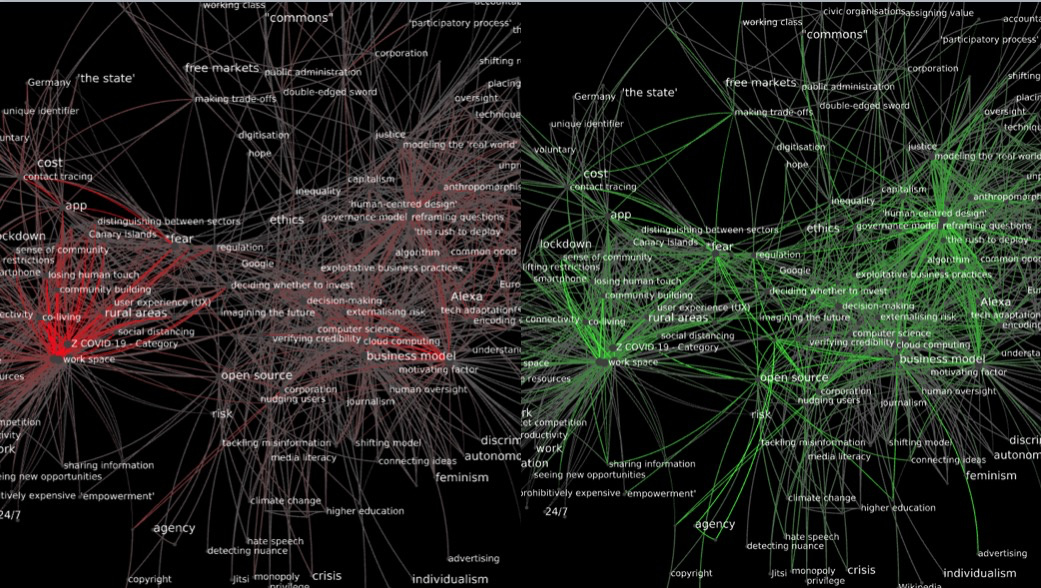This will be useful: https://hal-centralesupelec.archives-ouvertes.fr/hal-01986309/file/Core_Decomposition_VLDBJ.pdf (just found it and read it quickly)
You are absolutely right.
Is it me, but the file I just downloaded does not contain the stacked vs unstacked subgraphs, and does not include a nb_co_occ metric …
The simplest things is probably to just use the previous Tulip file and discard the self-loops.
I’m so sorry, @melancon, you are right. I have now committed a version of the file with all the stacked graphs.
Hello all, I have done a pass on the sections of the presentation assigned to me (Cryptpad). I am now stuck until I get your contributions and the visualizations from Bordeaux.
Hello all, I am now in the writing phase. I moved the text onto Overleaf, since Cryptpad is glitching. The edit link is here.
Please @Jan @Richard @melancon @bpinaud keep an eye on it and be reactive. I have less than three days to finish the text and record the video.
Guy, Bruno – still need the figures. Today I am on this, so do reach out if you need anything from me.
Hello Alberto,
online on zoom with Guy. See your emails. We have things to show and to ask.
Hi all, I am hard at work on the pre-paper. Question for @Jan and @Richard and especially @amelia : when you look at the codes co-occurrence network, how much do you reduce it normally? How many nodes/edges do you want to see?
Could you reply by lunchtime? I just need a sentence, even a number.
Morning! The German dataset isn’t as far along as the Polish and Czech, so I haven’t yet got to the stage where I am examining co-occurrences. But I think 5 was the was the minimum number than the Polish team used. As Jan is still asleep, I’m copying in @Wojt to see if he can confirm.
R
4/5/6. Right now, between 5 and 6.
And another major update. I just did a rehersal of the material we have (sections 1 to 3.2), and we are way beyond the time limit. The amount of ground we want to cover is just not realistic in this time limit. So I propose the following:
- Much shortened introduction, with no specific references (references only to traditions).
- Barebones description on how to generate and interpret the CC, ignoring the two-mode observation of reviewer 3.
- Only present two reduction techniques
This might do it.
@Bruno, @melancon, I believe you offered to edit the video file later, adding the images and the other slides (title of the paper, titles of the sections). Would this be an option? Then I could push to record everything before leaving, and then you would do the actual submission before July 2nd.
Immediate implications for Bruno: all I need immediately is
- the nicest possible version of the figure below as discussed, with POPREBEL data.
- a measure of distance. You could do this by picking the 50, 100, 500 and 1,000 highest co-occurrences edges in the unreduced network (I am now calling the number of co-occurrences
d, for association depth); and the 50, 100, 500 and 1,000 highest number of connectors edges (I am now calling the number of connectorsb, for association breadth); and compute a measure of distance (Jaccard coefficient seems an intuitive way to go, but Guy is the mathematician here) between the two
But if you have no time, I can just reuse the same picture, and lose the measures of distance. Speed is more important than thoroughness.

Hello,
I have computed the subgraphs for what we told yesterday I just need to report all numbers in a spreadsheet.
THe measure is not really a distance if I understand well. It is more a measure of the overlap between the different types of edges.
I will be able to work on this in some minutes (in a meeting which is close to the end)
Working in a spreadsheet on Google where I imported your .ods document. With a Google account, I can give you access.
Thanks. Just asked for access.
Meeting much longer than expected.
I confirm. If I am given rough video material (and even images, specs for titles) and indications on transitions etc. I can work out the video edition (@bpinaud knows how talented I am at video editing ![]() ).
).
I’ll also need the credentials for submission.
The edited video will display you playing saxophone, silhouetted against a dramatic Bordeaux sunset, I imagine ![]()
That’s very generous, thanks. I started recording the video files, and got to a nearly-complete draft of the presentation text (with figures) on the Overleaf file. If there are no further glitches, I will create a 12 minute “talking head” video (Alberto looking into the camera and delivering a version of the Overleaf text), with no figures. You can then edit the figures and saxophone music in, and submit while I’m gone.
Currently I have figures in the Overleaf. But I am unconvinced of them, I will leave you a comment about them.
currently fighting with Tulip and Python… not sure who is gonna win…
No worries Bruno, take your time.
I recorded sections 1, 2 and 3.1. I am now stopping, and will record section 3.2, 3.3 and the conclusions on Sunday evening. Seeing the light at the end of the tunnel.
I asked for access. See you email. I have completed a table with all edges overlapping between both measures (the intersection). I am now computing union to compute jaccard.
You should have access now (and so should Guy with his gmail address). Good work, thanks|